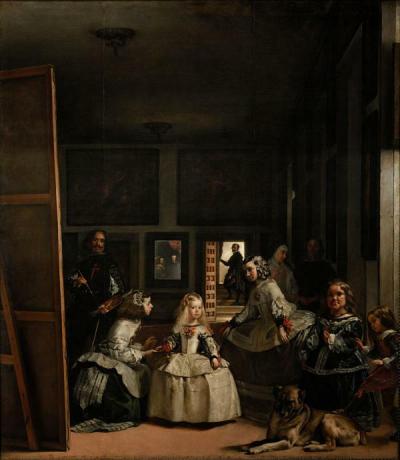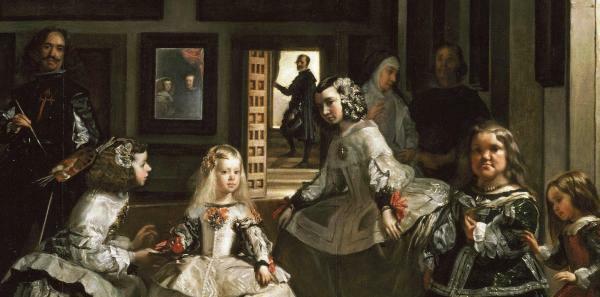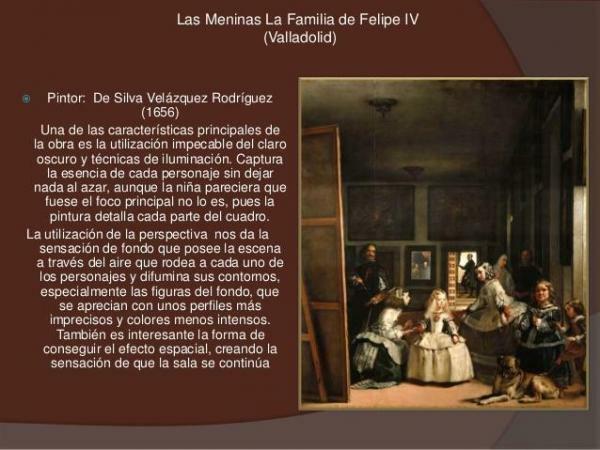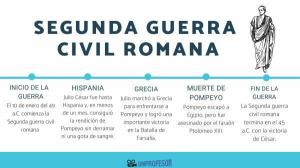Las Meninas de Velázquez - Commentary on the work

If you are not an expert in the history of art, you may not know that the painting that we currently know as Las Meninas, has gone through different denominations such as Portrait of the Empress, Her Ladies and a Dwarf wave Family of the Lord King Philip IV. What must be clear is that it was painted by one of the most important Spanish Baroque painters, Diego Velázquez, in 1656 just four years after his death.
Next in this lesson from a TEACHER we will try to offer a Commentary on the work Las Meninas by Velázquez, one of the most famous and largest paintings made by the painter, which is currently exhibited in the Museo Nacional de Prado.
Index
- Theme of Las Meninas de Velázquez
- Formal description of Las Meninas de Velázquez
- Interpretations of the Meninas by Velázquez
- Conclusions of Las Meninas de Velázquez
Theme of Las Meninas de Velázquez.
Las Meninas by Velázquez is a group portrait located in what was probably one of the rooms in the Alcázar of Madrid where the Sevillian painter had his workshop. The scene is
presided over by the presence of a young girl About five years old, it is the Infanta Margarita who is in the center of the composition, with Doña Isabel de Velasco to the right and Doña María Agustina de Sarmiento to the left of her.Also in the foreground the dwarves appear Nicolasito Pertusato and Mari Bárbola, at the feet of a beautiful mastiff that lies quietly on the ground. In the background, also on the right, there are two standing figures of which only one could be identified. Marcela de Ulloa, that she was the servant of the queen's ladies, the male has not yet been able to identify who it would be.
In the background, behind a doorway, Don José Nieto Velázquez, the queen's head of tapestry and possibly a relative of the painter. Further to the left we find ourselves reflected in a mirror at the Kings Philip IV and Queen Mariana of Austria.
By last, Velázquez, left, who appears self-portrayed with brush and palette in hands before a huge canvas wearing the long-awaited cross of the Order of Santiago. As an anecdote, it should be noted that this merit of obtaining the Cross of Santiago is an honor that he obtained three years after making said painting, so most of the experts agree that the cross was later painted by the artist and even that it was the king himself, Felipe IV, who painted it after the painter's death in 1660.
Finally, mention the two pictures on the back wall that have been identified and which are about copies of paintings by Rubens and Jordaens made by Juan Bautista Martínez del Mazo in which two mythological episodes are represented, Pallas Athena and Arachne Y Apollo conquering Pan.

Formal description of Las Meninas de Velázquez.
We continue with this Commentary on the work Las Meninas by Velázquez speaking now of the form and technique of the painting.
Regarding the technique, we see that it is a oil on canvas where Velázquez uses a fluid and long brushstroke alternating it with another more precise and shorter one that is the one he uses to outline the small details with great mastery, so that was able to convey to us and with an achieved realism the different textures such as the rigidity of the clothes of the infanta and ladies, the hardness of the wood or the softness of the fur of the dog.
We could say that her palette contains a great chromatic richness where dark colors predominate, highlighting some shades of black, white and red for some of the ornamental details of the clothes.
Another one of the exceptional things to discuss was the subject of light gathering, we see a room in semi-darkness with two different light sources, one of them the one that comes from the window to the left and the other the one that enters through the open door at the back.
We also see how Velázquez perfectly masters the subject of perspectives both the linear and the aerial, creating an existing atmosphere and that is achieved by blurring the contours of the different characters.

Image: Slideshare
Interpretations of the Meninas by Velázquez.
For some this work is nothing more than a simple family portrait, as if it were a photograph, showing us an anecdotal and fleeting moment, in which the Infanta accompanied at all times by her entourage breaks into the painter's workshop, who is at that moment portraying his parents, the kings who are the ones who are as we have already said before in the mirror in the background, so that it can be a painting with which to refer to how people lived in the court of Felipe IV.
However, Jonathan Brown, as well as other scholars, think that it is a work where you want emphasize the importance of painting as the noblest of the liberal arts, and for this conclusion is based on the close relationship that existed between the monarch and the painter, influencing that the painting is He was in the King's Summer Office where only the King himself and his most direct collaborators could enter it.
So there are those who say that what Velázquez wanted to do was a plea for the nobility of painting, comparing it for example with poetry that was considered an art and not a craft.

Image: Slideplayer
Conclusions of Las Meninas de Velázquez.
We end this comment on the work Las Meninas by Velázquez reaching the conclusions. We must be aware that it is one of the most important works made by Velázquez because it had a transcendence that many other Spanish painters could not have.
And it is that Velázquez, and in general his painting, became one of the fSources of inspiration for many later artists, among which it is worth highlighting the impressionist Manet who came to qualify him as “The painter of painters" Y Picasso who in 1957 and within his artistic style, cubism, represented in his way a painting that he also carried by name Las Meninas.
In this other lesson from a TEACHER we will discover the close relationship that existed between Picasso and cubism.
If you want to read more articles similar to Las Meninas de Velázquez - Commentary on the work, we recommend that you enter our category of Story.



